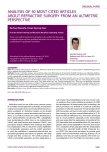Therapy for Vitreous Seeding Caused by Retinoblastoma. A Review
Léčba vitreálního seedingu retinoblastomu. Přehled
Retinoblastom je nejčastějším nitroočním maligním nádorem v dětském věku. Zásadní parametr určující stupeň retinoblastomu dle mezinárodní klasifikace retinoblastomu představuje seeding, neboli disperze nádorových partikulí do přilehlých kompartmentů. V článku jsme se zaměřili na vit reální seeding, jeden z hlavních limitujících faktorů úspěšné léčby retinoblastomu, při níž je zachován bulbus tzv. „eye-preservation treatment“. Člá nek shrnuje přehled vývoje léčby vitreálního seedingu retinoblastomu, zavedených postupů a zároveň seznamuje s novinkami na úrovni výzkumu. Zavedení systémové chemoterapie v léčbě retinoblastomu koncem 90. let znamenalo významný přelom, který umožnil postupné opuštění externí radioterapie s jejími vedlejšími účinky. Docílené koncentrace chemoterapeutik ve sklivcovém prostoru při systémové chemoterapii však nejsou pro léčbu vitreálního seedingu dostatečné a toxické účinky systémově podávaných chemoterapeutik nejsou zanedbatelné. Významnou změnou byl nástup chemoterapie in situ s cíleným podáváním chemoterapeutik, a to intraarteriálně a intravitreálně, což přispělo k definitivní eradikaci externí radioterapie a omezení systémové chemoterapie. Ačkoliv vitreální seeding zůstává nejčastějším důvodem selhání intraarteriální chemoterapie, tato technika výrazně ovlivnila původní léčebné schéma retinoblastomových dětí. Nejvíce se však zasloužila o zvýšení pravděpodobnosti zachování oka i zrakových funkcí u pacientů s pokročilým nálezem intravitreální chemoterapie. Nadále probíhá mnoho prací na vývoji nových terapeutických technik, a to s použitím periokulární aplikace chemoterapeutika, imunoterapie, genové terapie či onkolytických virů, z nichž se některé jeví jako slibné, ale k rutinnímu využití nejsou zatím dokončeny klinické studie.
Klíčová slova:
retinoblastom – vitreální seeding – léčba zachovávající bulbus – intravitreální chemoterapie
Authors:
M. Kodetová 1; K. Švojgr 2; J. Širc 3; J. Vaněček 1; P. Pochop 1
Authors place of work:
Oční klinika dětí a dospělých 2. LF UK a FN Motol Praha
1; Klinika dětské hematologie a onkologie 2. LF UK a FN Motol Praha
2; Ústav makromolekulární chemie Akademie věd ČR, v. v. i. Praha
3
Published in the journal:
Čes. a slov. Oftal., 80, 2024, No. Ahead of print, p. 1001-1007
Category:
doi:
https://doi.org/10.31348/2023/35
Summary
Retinoblastoma is the most common primary malignant intraocular tumor in children. Seeding, specifically the dispersion of the tumor into the adjacent compartments, represents a major parameter determining the degree of retinoblastoma according to the International Classification of Retinoblastoma. In this article we focused on vitreous seeding, one of the main limiting factors in the successful “eye preservation treatment” of retinoblastoma. This article presents an overview of the history of vitreous seeding of retinoblastoma, established treatment procedures and new-research modalities. The introduction of systemic chemotherapy in the treatment of retinoblastoma at the end of the 1990s represented a significant breakthrough, which enabled the progressive abandonment of radiotherapy with its attendant side effects. However, the attained concentrations of chemotherapeutics in the vitreous space during systemic chemotherapy are not sufficient for the treatment of vitreous seeding, and the toxic effects of systemic chemotherapy are not negligible. A significant change came with the advent of chemotherapy in situ, with the targeted administration of chemotherapeutic drugs, namely intra-arterial and intravitreal injections, contributing to the definitive eradication of external radiotherapy and a reduction of systemic chemotherapy. Although vitreous seeding remains the most common reason for the failure of intra-arterial chemotherapy, this technique has significantly influenced the original treatment regimen of children with retinoblastoma. However, intravitreal chemotherapy has made the greatest contribution to increasing the probability of preservation of the eyeball and visual functions in patients with advanced findings. Novel local drug delivery modalities, gene therapy, oncolytic viruses and immunotherapy from several ongoing preclinical and clinical trials may represent promising approaches in the treatment of vitreous retinoblastoma seeding, though no clinical trials have yet been completed for routine use.
Keywords:
retinoblastoma – vitreous seeding – eye preservation treatment – intravitreal chemotherapy
Štítky
OftalmológiaČlánok vyšiel v časopise
Česká a slovenská oftalmologie

2024 Číslo Ahead of print
- Cyklosporin A v léčbě suchého oka − systematický přehled a metaanalýza
- Myasthenia gravis: kombinace chirurgie a farmakoterapie jako nejefektivnější modalita?
- Syndrom suchého oka
- Pomocné látky v roztoku latanoprostu bez konzervačních látek vyvolávají zánětlivou odpověď a cytotoxicitu u imortalizovaných lidských HCE-2 epitelových buněk rohovky
- Konzervační látka polyquaternium-1 zvyšuje cytotoxicitu a zánět spojený s NF-kappaB u epitelových buněk lidské rohovky
Najčítanejšie v tomto čísle
- ZRAKOVÁ NEUROPROTÉZA – STIMULACE ZRAKOVÝCH KOROVÝCH CENTER V MOZKU. NÁVRH NEINVAZIVNÍ TRANSKRANIÁLNÍ STIMULACE FUNKČNÍCH NEURONŮ
- VYHODNOCENÍ KLINICKÝCH VÝSLEDKŮ IMPLANTACE TORICKÝCH NITROOČNÍCH ČOČEK VČETNĚ JEJICH ROTAČNÍ STABILITY
- POUŽITÍ SKLÉRÁLNÍCH ŠTĚPŮ V OČNÍ CHIRURGII. PŘEHLED
- Vogt-Koyanagi-Harada Disease: The Clinical Spectrum and Management of Case Series in a Tertiary Eye Centre in Northern Part Of Malaysia
